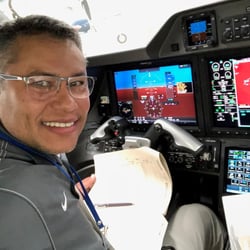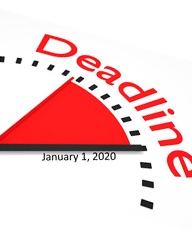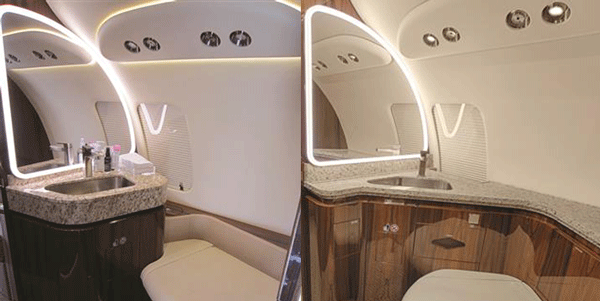“Once he saw the 3D renderings with the materials selected, he signed the contract, and we got to work.” Rachael Weverka, Duncan Aviation Lead Designer
Duncan Aviation Lead Designer Rachael Weverka recently worked with a customer who wanted extensive renovations on his G-V (Gulfstream V). He was a designer’s dream in that he was easygoing, knew what he wanted, and was open to her ideas. But before he would sign a contract, he wanted to see how the colors, patterns, and materials all came together.
Rachael worked with Dan Ryba, one of Duncan Aviation’s Multimedia Illustrators, who produced 3D renderings of what an aircraft would look like with the proposed design.
“I’d met with our customer at his hangar, and he was anxious to get started on the project because he had an upcoming flight overseas and needed the renovations completed prior to that trip,” says Rachael. “Once he saw Dan’s 3D renderings with the materials selected, he signed the contract, and we got to work.”
Completions and Modifications Sales Representative Joep Cuppens also worked on the project, which included complete custom-designed exterior paint.
“We can’t all envision what a finished project is going to look like, and the 3D renderings really take away the guess work,” says Joep. “Several of my customers have asked for them, and they’re delighted by what they see. Even better, they’re especially pleased that the finished product looks like the 3D renderings.”



Photos: Left-before interior refurbishment; Middle-3D rendering; Right-after interior refurbishment
Carpet conundrum
The time frame for the workscope was a bit tight, and Rachael immediately ran into a potential delay.
“The owner liked the concept of his existing carpet but wanted to change it slightly for an updated look,” says Rachael. “Unfortunately, the existing carpet required all hand-stitching, which adds quite a bit of time to the manufacturing process. We knew that wasn’t an option, so I redesigned it to be mostly machine-made with some custom overtufting for the pattern.”
After discussing the predicament with the carpet manufacturer, Rachael was told if she created the computer templates for the repeating patterns that she had designed, they could make the carpet according to her specifications. She created the templates and sent them to the manufacturer. Using those templates, the machine that stitched the carpet incorporated Rachael’s patterns, and the manufacturer was able to make and deliver the carpet on time, keeping the project on its tight schedule.
It’s all in the details
In addition to paint, the exterior renovations included new steps, which were a unique design with their polished aluminum panels for the risers and black step tread. The mirrored finish is quite striking, and the customer loved them!
Rachael’s designs made big changes to the interior of the aircraft, right down to the smallest detail. For instance, the faucet was a standard faucet that needed to be updated to match the new interior. Rachael had a faucet in mind; it was one she’d used on another G-V.
“This new faucet is a lot like the one that’s commonly used on many aircraft but is constructed to be more durable,” says Rachael.
The new black Corian countertops served as perfect complements to the veneer with its dark grain, and the eye-popping cream accents kept the cabin from appearing too dark. The black pinstriped divan brought in some masculinity, and the soft, cashmere-covered pillows at every seat provided warmth and contrast.
For extra comfort during overnight flights in and out of the United States, Rachael found a company that makes custom linens, pillows, and foam beds that are contoured to each seat.
“The big challenge for this project was the time frame; we wanted to meet the original delivery date so the customer could use this aircraft for an overseas flight,” says Rachael. “With the quick decisions by the owner, and the incredible efforts of all of the team members who worked on this aircraft, we were able to deliver on time. The owner ended up not being able to go on his overseas trip, but the aircraft was ready if he needed it. Instead, he ended up taking delivery in time to make multiple flights to evacuate his family ahead of Hurricane Irma.”
Spring 2018 Duncan Debrief
You can read more about this and other articles in the 2018 Spring Duncan Debrief.



 Duncan Aviation has spent the last 5 years educating our customers about the FAA’s upcoming mandate deadline for ADS-B Out (Automatic Dependent Surveillance-Broadcast Out). We’ve also performed hundreds of upgrades at our full-service facilities in Battle Creek, Michigan; Lincoln, Nebraska; and Provo, Utah. Duncan Aviation’s network of Satellite Avionics Shops have performed more than 500 installations and even have a dedicated reservation program to make it easier for our customers to get their aircraft into compliance before the deadline at 12:01 am on January 1, 2020.
Duncan Aviation has spent the last 5 years educating our customers about the FAA’s upcoming mandate deadline for ADS-B Out (Automatic Dependent Surveillance-Broadcast Out). We’ve also performed hundreds of upgrades at our full-service facilities in Battle Creek, Michigan; Lincoln, Nebraska; and Provo, Utah. Duncan Aviation’s network of Satellite Avionics Shops have performed more than 500 installations and even have a dedicated reservation program to make it easier for our customers to get their aircraft into compliance before the deadline at 12:01 am on January 1, 2020. “When we upgrade your aircraft for ADS-B, our techs perform the ground testing required by AC 20-165b to verify the ADS-B integrity before the aircraft flies,” says Manager of Satellite Operations Matt Nelson.
“When we upgrade your aircraft for ADS-B, our techs perform the ground testing required by AC 20-165b to verify the ADS-B integrity before the aircraft flies,” says Manager of Satellite Operations Matt Nelson.
 An hour later, the Phenom was on its way to Miami, Florida, 3 ½ hours away. Before flying back to Atlanta, Edduyn visited a local market, where he sampled wares from a few food vendors. His favorite was bandeja paisa (paisa platter), the national dish of Colombia.
An hour later, the Phenom was on its way to Miami, Florida, 3 ½ hours away. Before flying back to Atlanta, Edduyn visited a local market, where he sampled wares from a few food vendors. His favorite was bandeja paisa (paisa platter), the national dish of Colombia. Everyone at Duncan Aviation laughed along with most of the rest of the business aviation industry on April Fool’s Day when the spoof press release claimed the deadline for the Automatic Dependent Surveillance-Broadcast (ADS-B) mandate had been extended until 2040. Not long after the laughter died down, though, the FAA reiterated that the agency’s deadline will not change, saying, “We have a sense of humor, too, but an April Fool’s joke that the FAA is extending the ADS-B deadline is just that.”
Everyone at Duncan Aviation laughed along with most of the rest of the business aviation industry on April Fool’s Day when the spoof press release claimed the deadline for the Automatic Dependent Surveillance-Broadcast (ADS-B) mandate had been extended until 2040. Not long after the laughter died down, though, the FAA reiterated that the agency’s deadline will not change, saying, “We have a sense of humor, too, but an April Fool’s joke that the FAA is extending the ADS-B deadline is just that.” Because time flies and aircraft without ADS-B probably won’t after the deadline, Duncan Aviation would like to remind its customers that the company has numerous certified paths to upgrade equipment to comply with the FAA’s ADS-B mandate. Duncan Aviation holds (or has access to) 42 STCs for dozens of aircraft models.
Because time flies and aircraft without ADS-B probably won’t after the deadline, Duncan Aviation would like to remind its customers that the company has numerous certified paths to upgrade equipment to comply with the FAA’s ADS-B mandate. Duncan Aviation holds (or has access to) 42 STCs for dozens of aircraft models. Sean is an Inspection Unit Member for Duncan Aviation’s ODA and Project Planner for the company’s highly regarded Engineering & Certification Services Alterations Planning Team. With more than 20 years of experience at Duncan Aviation, four years in the United States Navy as an avionics electrician, a degree in avionics from Spartan College of Aeronautics and Technology in Tulsa, Oklahoma, and a certified A&P maintenance tech, Sean is fully prepared to provide information and answer questions about engineering and certification.
Sean is an Inspection Unit Member for Duncan Aviation’s ODA and Project Planner for the company’s highly regarded Engineering & Certification Services Alterations Planning Team. With more than 20 years of experience at Duncan Aviation, four years in the United States Navy as an avionics electrician, a degree in avionics from Spartan College of Aeronautics and Technology in Tulsa, Oklahoma, and a certified A&P maintenance tech, Sean is fully prepared to provide information and answer questions about engineering and certification.  Duncan Aviation and its multi-shop capabilities can save you a whole lot of money.
Duncan Aviation and its multi-shop capabilities can save you a whole lot of money.  Today, buyers who are in the market for a new aircraft echo the sentiments of their terrestrial home-buyers in that they want a move-in-ready, or take-to-the-skies-ready, aircraft.
Today, buyers who are in the market for a new aircraft echo the sentiments of their terrestrial home-buyers in that they want a move-in-ready, or take-to-the-skies-ready, aircraft. “Even with the small number of buyers who see zero value for themselves in having a connected aircraft, we point out that installing internet adds at least 50% of the installation cost to the aircraft resale value,” says Roth. “The majority of buyers looking for aircraft today want an internet connection.”
“Even with the small number of buyers who see zero value for themselves in having a connected aircraft, we point out that installing internet adds at least 50% of the installation cost to the aircraft resale value,” says Roth. “The majority of buyers looking for aircraft today want an internet connection.” DOM Greg Donegan, at Cincinnati, Ohio-based Cin-Air, had an inspection due on a G-200 in October 2016. While it was down, he had the Duncan Aviation techs from the Satellite Shop at Lunken Field in Cincinnati cross the ramp from their hangar to his and upgrade the G-200’s avionics equipment for ADS-B.
DOM Greg Donegan, at Cincinnati, Ohio-based Cin-Air, had an inspection due on a G-200 in October 2016. While it was down, he had the Duncan Aviation techs from the Satellite Shop at Lunken Field in Cincinnati cross the ramp from their hangar to his and upgrade the G-200’s avionics equipment for ADS-B.
 The Duncan Aviation Senior Completions Designer and Team Leader Mary Lee and Multi Media Illustrator Ken Reita worked together to find a way to give passengers more headroom in the lavatory of a Challenger 650.
The Duncan Aviation Senior Completions Designer and Team Leader Mary Lee and Multi Media Illustrator Ken Reita worked together to find a way to give passengers more headroom in the lavatory of a Challenger 650.
 The avionics experts at Duncan Aviation know that most passengers aboard business aircraft want to stay connected as they travel. A connected aircraft lets cabin passengers access the internet in flight.
The avionics experts at Duncan Aviation know that most passengers aboard business aircraft want to stay connected as they travel. A connected aircraft lets cabin passengers access the internet in flight.
